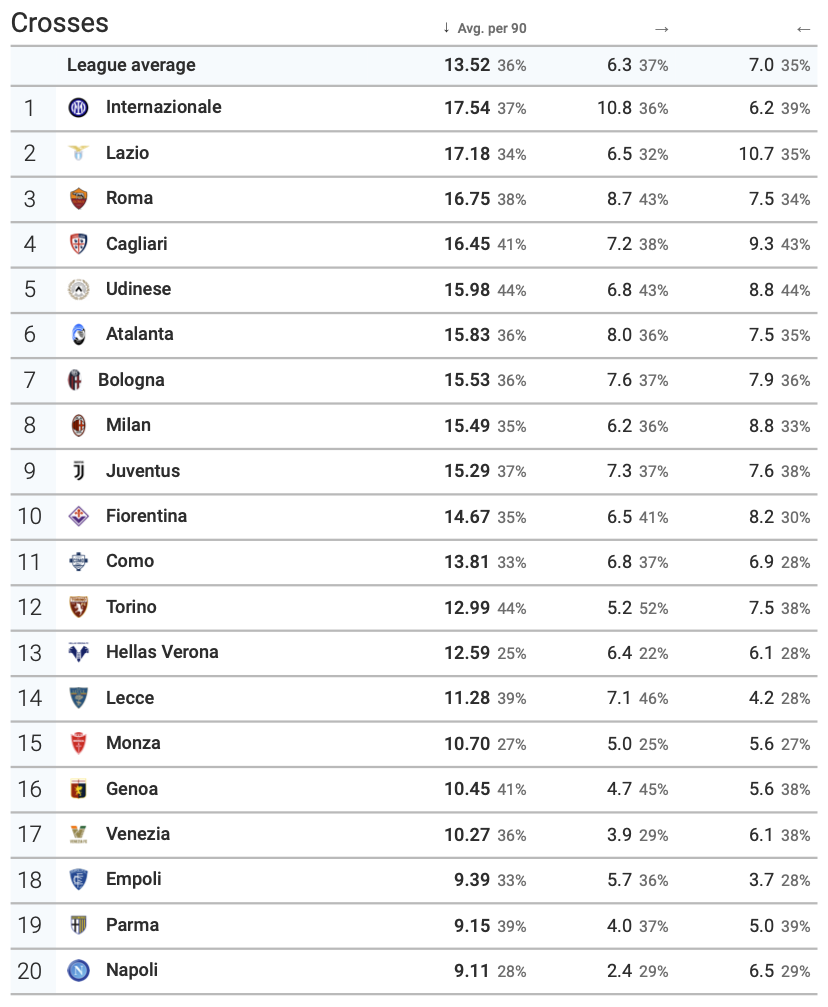Three Interesting Statistics About Conte’s Napoli

In this article, we look at some interesting statistical facts about the current Serie A leaders: Antonio Conte’s Napoli.

The main reason is the presence of Romelu Lukaku, who has always been a focal point in Conte’s attacking systems. Napoli players often look to play vertically toward the Belgian striker, who, with his back to goal, is tasked with laying the ball off to teammates to link up plays in the final third. Since Lukaku gravitates toward the right center and absorbs much of the passing, it follows that Napoli’s possession frequently flows through that side.
Other factors also contribute to diverting Napoli’s play away from the left. Kvaratskhelia, for instance, moves freely from the left wing toward the center, thus distributing his touches and influence across different areas of the pitch. Meanwhile, the players on the right-hand side are more suited to the one- or two-touch combinations that are characteristic of Conte’s football. Kvara, with his unpredictability, makes it harder to move up the field in that manner compared to Politano, Anguissa, and Di Lorenzo, who are more inclined to follow their coach’s tactical orders.
Dribbling
Another surprising statistic, this time due to Conte’s style rather than his players, is Napoli’s heavy reliance on dribbling. At present, the Azzurri rank third in Serie A for attempted dribbles per 90 minutes, with 23.96 attempts and a success rate of 59%. Only Juventus and Roma have attempted more.
Conte’s relationship with dribblers is complex and difficult to summarize. Starting out as the prophet of the 4-2-4 system with which he won Serie B at Bari in 2008/09, much of that team’s success came from the flair of wingers like Guberti, Kamata, and Rivas. At Juventus, he struggled to find wingers of similar quality in players like Krasić and Elia, which led him to shift to a 3-5-2 formation. Generally speaking, during his Serie A tenures, Conte hasn’t relied heavily on dribbling, preferring to build teams with finely-tuned mechanisms, like a true watchmaker.
Things were different in the Premier League, where the qualities of players at Chelsea and Tottenham, combined with the opportunity to attack in transition (something opponents in Serie A rarely allowed, as they often sat deep), encouraged him to rely more on dribblers like Hazard, Willian, Son, and Kulusevski.
At Napoli, we’re seeing a version of Conte closer to his English days. Kvara, especially, but also Politano, are wingers who can influence the game through dribbling. Both are among the top 10 in Serie A for total dribbles attempted: Politano is 10th (37), while the Georgian is first (55).

Kvara is also first in the league for Progressive Runs (37), further demonstrating how carrying the ball remains crucial for Napoli, even under Conte. Other players also contribute to the dribbling stats: Neres is as in love with dribbling as Kvaratskhelia and Politano, Lobotka can evade any opponent under pressure, and Zambo Anguissa is adept in tight spaces and enjoys surprising opponents with his ball-carrying ability.
Compared to his time at Juventus and Inter, Conte now has more individual solutions to try something different.
A Team That Crosses Less
The fact that 35% of Napoli’s attacks are directed centrally and that they rely on inverted wingers like Kvaratskhelia and Politano, who naturally cut inside, means that the team rarely looks to cross. Napoli currently crosses less than any other team in Serie A: only 9.11 crosses per game, a figure more in line with newly promoted sides like Parma and Venezia or relegation battlers like Empoli and Genoa, rather than the league’s top clubs.

Conte has never been a coach who overuses crosses, yet they have always been part of his arsenal. For instance, alongside Gasperini and Mazzarri, he institutionalized the wing-to-wing cross in European football—something we’ve yet to see at Napoli. Who knows, maybe the return of a full-back like Spinazzola, who likes to beat his man to deliver a cross, might increase the number of crosses attempted by Napoli.
Start your 15-day Wyscout free trial now.
Visit L’Ultimo Uomo website.
